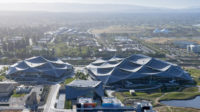The east and north facades were opened up to install 81 operable windows and two industrial-style roll-up doors. The windows provide a large amount of daylighting that makes the DPR office almost entirely free of artificial light during the day. Eighty-two Solatubes work in tandem with the windows and provide enough direct overhead lighting to eliminate 70% of the electric lighting load. A lighting control system is programmed to dim the office lights gradually on or off depending on the intensity of outside light. In the San Diego office, which doesn't have the system, employees would notice a jarring on/off transition from artificial to natural light, Robertson says.
The windows also serve as an integral part of the building's passive cooling system. An energy monitoring system reacts to the desert heat and wind speed by opening the windows to allow natural air flow and, when appropriate, activating "shower" towers that use evaporative cooling from water mist to reduce the inflow air temperature to comfortable levels.
Inside the open-style office, air is allowed to flow freely around the 58 workstations, propelled by a dozen 8-ft-dia fans.
The centerpiece of the cooling system—and the building interior—is the 87-ft-long, zinc-clad solar chimney, which expels heat from the building as it naturally rises. This in turn creates a convection current that pulls more cool air into the workspace via the windows and shower towers.
Many of these concepts have been used for centuries by desert dwellers. "Bringing sunlight from above and using evaporative cooling are very old technologies, but what we did is put them together with a very robust control system," Robertson says. "With our building management system, the sky's the limit. We can program it however we want."
While most office buildings in Phoenix stay 68˚F year-round, DPR's office provides a more realistic response to natural weather fluctuations and puts employees better in touch with their surroundings.
Because of humanity's impact on the environment, "people have to acclimate to this necessary normal," says James Dinan, president/CEO of Bel-Aire Mechanical, a design-assist subcontractor.
Proof of Concept
As part of the consideration for net-zero status, the building must undergo a year of energy monitoring, which ends on Dec. 1. So far, the building is on track to generate as much energy as it uses annually, aided by a 79-kW photovoltaic system that also shades the parking area. At night, workers throw a "vampire" switch to thwart any electrical devices—microwaves, cellphone chargers, radios—that may be drawing energy from power plugs when there are no occupants in the building.













